Introduction
You put together a great team for your project.
Everyone’s an expert in their area, a real dream team.
But soon, people started arguing about the best way to proceed, deadlines started slipping, and everyone felt frustrated and unsure who was responsible for what.
Sound familiar?
Many project managers and team leaders face this reality because team roles are not clearly defined. The team loses the balance between roles and responsibilities, and suddenly, agreements are hard to achieve.
The solution lies in creating a balanced team. Now, I’m not talking about just having the right skills; of course, you need those for the actual work.
By balanced team, I mean the balance between the behavioral roles each team member will play.
In this article, we will discuss Dr. Meredith Belbin’s Team Roles framework, a popular tool for building a balanced team by assigning roles based on behavioral strengths and weaknesses.
We will learn how this balanced approach can improve the performance of your project teams.
What are Belbin Team Roles?
The Belbin Team Roles theory, pioneered by Dr. Meredith Belbin, a British researcher and management theorist, originated from a unique study conducted at Henley Business School. This theory emerged from the observation of several business professionals participating in games, providing valuable insights into team dynamics.
Dr. Belbin’s research unveiled nine distinctive behavioral clusters, or team roles, that shape how individuals contribute to and behave within a team. Based on successful and unsuccessful team dynamics observed during the study, researchers developed these roles.
The model highlights the importance of team diversity, not just in terms of skills but also in terms of behavioral tendencies. A well-balanced mix of these roles allows teams to achieve optimal performance in problem-solving, decision-making, risk management, etc.
9 team roles to create a balanced team
Having the right talent on a team is necessary, but not just enough. However, a great football team isn’t just all forward players – it needs a strong defense to balance the offense’s firepower.
Similarly, in a project team, you have to match that talent perfectly with a role. These roles aren’t just about skills, but also about natural behaviors and how individuals contribute to the team dynamic.
The Belbin’s Team Roles mentioned below will provide you with a framework that identifies nine distinct roles, to perfectly align your team members with the right responsibilities.
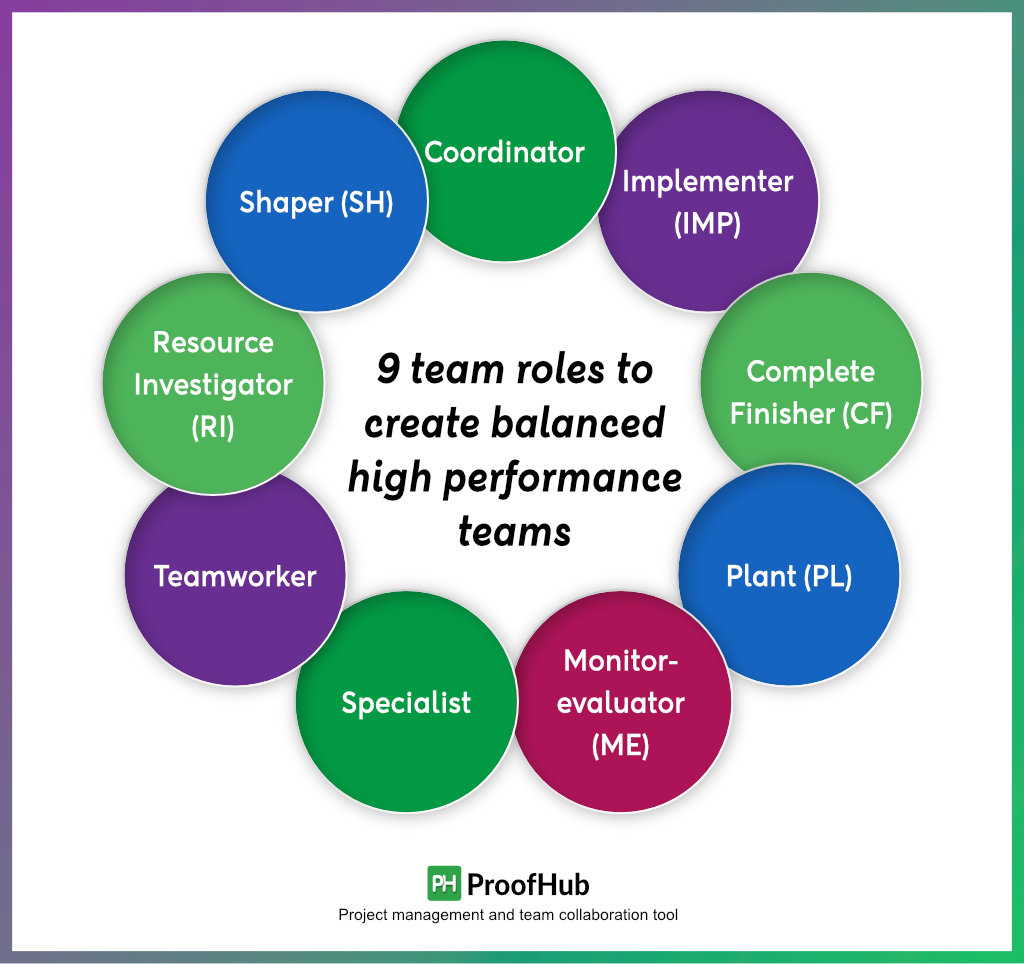
1. Coordinator (CO)
The Coordinator, as the confident team captain, focuses on getting the best out of the team by clarifying goals and delegating effectively. Their main responsibility is to keep the team on track and ensure they meet deadlines without any delay.
The Coordinator also clarifies decisions, helping everyone else focus on their tasks. Their role as a leader is to create a high-performance culture for the team.
Key characteristics of a Coordinator:
- Strong communication skills: They can clearly explain objectives, expectations, and project details to the team.
- Skilled at delegation: They can assess team members’ strengths and weaknesses to assign tasks effectively.
- Excellent organization: They can keep track of project progress and ensure deadlines are met.
Coordinator (CO) strengths: Coordinators play a pivotal role in team cohesion, holding the team together and ensuring a smooth workflow. Moreover, their adeptness at delegating tasks enables better resource allocation and enhances productivity.
Coordinator (CO) weaknesses: While delegation is a strength, some Coordinators might overuse it, leaving them solely focused on assigning tasks without actively contributing themselves. Additionally, team members may perceive their focus on efficiency as manipulation, especially if they communicate unclearly.
Who should be a Coordinator (CO) on your project team?
Coordinators, being natural leaders with excellent communication and organizational skills, are crucial for project success. Depending on the nature and complexity of your project, seek someone who embodies one of the five leadership styles. Additionally, it’s essential to find someone who can clearly and concisely communicate project goals and expectations. Moreover, a Coordinator must possess a strong understanding of individual team members’ strengths and weaknesses.
2. Implementer (IMP)
The Implementer is the team’s “get-it-done” person. They take big ideas and plans and break them down into clear, actionable steps. This role often falls to the project manager in traditional project management structures. However, within agile frameworks like Scrum, the Scrum Master might fulfill this responsibility by facilitating work breakdown into manageable tasks during sprint planning.
Key characteristics of an Implementer (IMP):
- Strong Analytical Skills: They can break down complex problems into manageable steps.
- Process-oriented: They thrive on creating and following efficient workflows.
- Keen attention to detail: They ensure tasks are completed according to established quality standards.
Strengths of implementers: Implementers serve as the backbone of any project, adeptly transforming ideas into reality. With their strong organizational skills and focus on efficiency, they keep the team on track and ensure tasks are completed effectively.
Implementers weaknesses: While Implementers excel at established processes, they might be hesitant to embrace entirely new ideas. Additionally, their focus on completing tasks can overshadow opportunities for innovation or going the extra mile.
Who should be an Implementer on your project team?
The Implementer on your team should have a strong understanding of various management styles. Look for someone who has shown the ability to adapt to changing priorities while maintaining efficiency. Someone with experience in utilizing resources to their best advantage.
Read more: 9 best resource scheduling software for project managers
3. Complete Finisher (CF)
The Completer-finisher is the team member who ensures that the team’s work is completed to the highest standards and that all details are correct. They are usually addressed as “perfectionists.”
They have a high standard for quality and are vigilant about catching errors or oversights before they become bigger problems.
Key characteristics of a Complete Finisher (CF):
- High attention to detail: They have a keen eye for spotting errors and inconsistencies.
- Strong work ethic: They are dedicated to completing tasks to the best of their ability and meeting deadlines.
- Methodical approach: They follow a systematic plan to ensure nothing is missed.
- Goal-oriented: They are driven to achieve the desired outcome and see projects through to completion.
Complete-finisher (CF) strengths: Once they commit to a task, they see it through to completion, ensuring all details are addressed and nothing falls through the cracks. They excel at staying organized and keeping track of multiple tasks simultaneously.
Complete-Finisher (CF) weaknesses: Complete finishers, however, can face struggles if changes are rushed through. They might become overwhelmed by the pressure of meeting the standards and mess up the task altogether.
Who should be a Complete-Finisher on your project team?
The ideal candidate for a Completer-Finisher role is someone who thrives on accuracy and takes pride in delivering high-quality work. Look for team members with a proven track record of meeting deadlines and exceeding expectations. strong organizational skills and the ability to manage multiple tasks effectively.
4. Plant (PL)
The Plant (PL) is a team’s ideas generator. They are known for their creativity, imagination, and unconventional thinking. These strengths make them masters of coming up with “out-of-the-box” solutions and innovative approaches to problems. They excel at identifying opportunities even during crises, bringing a fresh perspective that can lead to breakthroughs.
Here are the few key characteristics of a Plant:
- Creativity and imagination: Plants excel at generating innovative ideas and solutions. They approach problems from unconventional angles, coming up with “out of the box” thinking.
- Problem-Solving: Plants are valuable assets when a team gets stuck. They can identify new perspectives and breakthrough ideas.
- Opportunity recognition: Plants have a knack for spotting opportunities, even in challenging situations (like crises).
- Independent thought: Plants thrive on deep concentration and independent thinking. They may appear isolated while fully immersed in their work.
Plants’ strength: Plants thrive on independent thought and deep concentration. They might appear isolated while fully immersed in their work. When the team is stuck, their unconventional thinking can lead to breakthroughs, offering fresh perspectives and innovative solutions.
Plants’ weaknesses: While they excel at brainstorming, translating those brilliant ideas into actionable plans might require collaboration with more grounded team members. Additionally, a plant’s independent thinking style might create a communication gap, requiring them to clearly explain their concepts for the team to fully understand and implement their innovative visions.
Who should be the Plant (PL) in your project team?
Plants are not hard to spot. They are the team members who constantly propose new and innovative ideas, aren’t afraid to challenge the status quo and develop new and unconventional solutions. Look for someone who can see connections between seemingly unrelated concepts and spark exciting possibilities.
5. Monitor-evaluator (ME)
A monitor-evaluator is a team’s analytical observer. They are critical in ensuring decisions are made with clear-headed rationality and strategic foresight.
Unlike some team members who might be swayed by enthusiasm, the Monitor-Evaluator thrives on impartiality. They meticulously dissect ideas, separating emotions from logic. They prioritize strategic thinking, even if it may lead to some bruised feelings. Despite who came up with the idea, they are more interested in its contents and the facts supporting it.
As an analytical thinker, they consider factors like:
- Alignment with Goals: Does the idea directly contribute to the organization’s overarching business objectives?
- Feasibility and risk: Is the idea realistic and achievable? What potential pitfalls exist?
- Data-driven decision-making: They leverage facts and figures to support their judgments, not hunches or gut feelings.
A monitor evaluator must skillfully predict potential problems and identify early warning signs of threats. This proactive approach helps the team avert worst-case scenarios.
- Monitor-evaluator’s strength: Monitor Evaluator plays the role of an end customer who does not share the team’s enthusiasm and judges the product based on its ups and downs. This judicious nature helps teams keep things realistic and not go overboard with the idea.
- Monitor-evaluator weakness: The overly critical nature of a monitor evaluator may cause them to overlook the potential of ideas that are unlikely to work. If they don’t see the idea working, they might pour cold water on it. This can lead to friction among team members, making them hesitant to openly present new ideas.
Who should be the Monitor-Evaluator (ME) on your project team?
If you are looking for someone to be your team’s monitor evaluator, look for someone who’s more about logic, and less about drama. They’ll give it to you straight, no sugarcoating, and sweat the details to make sure their feedback is fair. However, if entrusting this role to someone in a leadership position, ensure they possess adaptive leadership skills to effectively guide and motivate the team based on their evaluations.
6. Specialist (SP)
A specialist is the team’s go-to expert. Their expertise and experience in a particular field make them invaluable assets. A team might have more than one Specialist, each with expertise in one field.
Their in-depth knowledge and expertise in a particular domain make them reliable sources of truth for anybody with questions. They are recognized as authorities in that area and provide insights on moving forward in that direction.
Key characteristics of the Specialist:
- Single-minded: Specialists are often passionate about one single thing. They are rarely interested in other domains and dedicatedly follow the one they are interested in.
- Self-starting: Specialists are known for their ability to work independently and take initiative in their areas of expertise.
- Narrow focus: Since they possess a deep understanding of something.
Specialists bring a unique perspective and skillset to the table, filling critical knowledge gaps within the team. This specialized knowledge is often not readily available elsewhere, making them a vital resource for success.
- Specialists’ strength: Specialists are recognized for their high level of professionalism, depth of knowledge, and commitment to their area of expertise, acting as the authority on all technical and practical considerations related to their field.
- Specialists’ weakness: Due to their deep focus on a narrow area, They may face challenges in interacting with team members with different expertise or engaging effectively in team discussions that go beyond their specialized field.
Who should be a specialist in your project team?
As the name suggests, the team member with the most hands-on experience in a particular domain becomes the Specialist in that domain. They stay up-to-date on the latest advancements in their field and enjoy diving deeper into complex topics.
7. Resource Investigator (RI)
A resource investigator is the detective of the team. They are constantly looking for new resources that a project team might need to make their job easier. This can include finding experts, project management software, or even funding.
A resource investigator is a people-oriented role. They can often be found talking to people outside the team and attending events so that they can keep themselves updated with the latest trends and technologies.
Key characteristics of a Resource Investigator (RI):
- Outgoing: Resource investigators like meeting new people and talking to them.
- Enthusiastic: RIs are usually curious and like exploring new topics or domains. They get excited about new ideas, bringing new perspectives to the team.
- Motivating: They often share their enthusiasm for new ideas with the rest of the team.
Resource Investigator (RI) strength: A resource investigator can easily establish contact and network outside the team. This helps them gather information that might be beneficial for the project. They are usually good at negotiating with external resources and making sure to maximize the value.
Resource Investigator (RI) weaknesses: They can sometimes get a little carried away by their initial excitement, becoming overly optimistic and losing interest quickly. They might also get bogged down without a deadline and focus on exploring all the possibilities rather than getting things done. To keep their brilliance in check, they work best with teammates who can ensure follow-through and practical results.
Who should be a Resource Investigator on your project team?
To find the best fit for the role of resource investigator in your team, look for a person who is a little extroverted. Ideally, they’ll be energized by challenges and motivated by the thrill of finding something new and useful. Additionally, if they are good at negotiating terms, that is a bonus.
8. Shaper (SH)
A shaper is also an action-oriented role that is mostly focused on driving the team to produce the required results. They can often come across as challenging and passionate about keeping the team focused, restricting them from losing sight of the goals.
Shapers take challenges head-on and thrive under pressure. They actively take part in discussions and follow a solution-oriented approach to quickly achieve the end results.
Here are a few characteristics of the Shaper (SH):
- Challenge-Seekers: Shapers enjoy tackling obstacles and coming up with innovative solutions.
- Competitive Drive: They have a strong desire to win and achieve goals, motivating the team to excel.
- Outspoken: Shapers aren’t afraid to voice their opinions and debate ideas, ensuring a lively exchange.
Shaper’s strength: Shapers’ ‘can-do’ attitude and dynamic nature make them natural communicators when it comes to selling an idea. They can clearly articulate the problem, propose their solution with reason, and acknowledge potential limitations with a focus on how they’ll be overcome.
Shaper’s weakness: Shapers might come across as pushy. They may frustrate or irritate others with their drive and ambitious approaches. Also, they might find themselves in friction with a less ambitious member of the team.
Who should be the Shaper (SH) in a project team?
Look for someone who enjoys tackling challenges and can see issues from different angles. Moreover, they should be comfortable voicing their ideas and motivating others to achieve ambitious goals. However, their drive shouldn’t come at the expense of being considerate of others’ feelings.
The best Shaper isn’t just someone with the most forceful personality. Someone who possesses the necessary leadership skills makes for a good shaper. It’s someone who can leverage their strengths for creative problem-solving and drive the team forward in a respectful environment.
9. Teamworker (TW)
According to Belbin’s team role model, a teamworker is crucial in facilitating team dynamics and cohesion. They focus on promoting unity within the team, nurturing positive relationships, and ensuring effective communication among team members.
Their interpersonal skills, empathy, and ability to mediate conflicts make them instrumental in maintaining a supportive and collaborative team environment.
Key characteristics of the Teamworker:
- Relationships builder: Teamworkers excel at building strong relationships with team members, creating a sense of unity and trust within the team.
- Supporting: They provide emotional support, encouragement, and assistance to team members, helping to boost morale and motivation during challenging times.
- Mediating conflicts: Skilled team workers resolve conflicts and promote a harmonious atmosphere within the team, ensuring constructive addressing of disagreements.
- Effective communication: They ensure open and transparent communication among team members, thereby facilitating smooth information flow and ensuring that everyone hears and understands each other clearly.
Overall, the team worker’s role is essential for everyone to play. You need a team of collaborative players with a sense of unity and cooperation among team members in the pursuit of common goals.
How to create a balanced team?
Creating a successful team requires a thoughtful approach. Dr. Meredith Belbin’s team roles framework offers a valuable tool for identifying and leveraging the individual strengths of the team members.
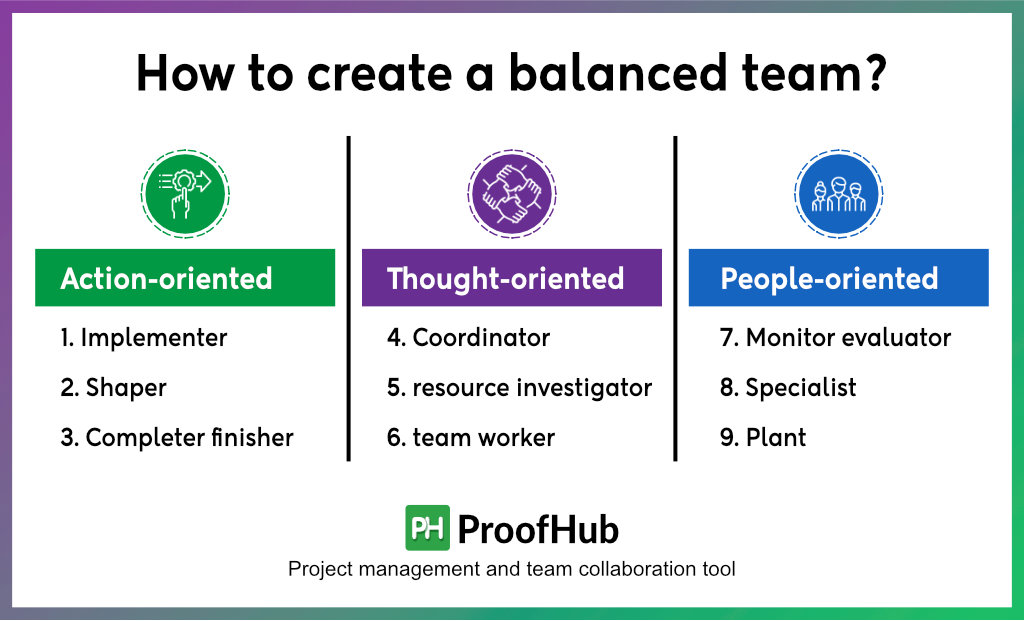
To create a balanced team, the above-discussed nine distinct team roles can be categorized into three key areas:
- Action-oriented: These individuals excel at driving tasks forward and turning ideas into action. For instance, Implementers are known for their efficiency and reliability, while Shapers are persuasive and challenge the status quo.
- Thought-oriented: These team members focus on generating ideas and critical analysis. Specifically, Thinkers include Plants, known for their creativity, and Monitor Evaluators, who provide a logical and analytical perspective.
- People-oriented: These roles prioritize collaboration and interpersonal dynamics. For instance, team workers build trust and rapport, while coordinators keep everyone focused and facilitate communication. Resource Investigators play a vital role by seeking external opportunities and information.
Moreover, a balanced team thrives on its diversity. For example, a strong Plant in the team can generate creative ideas, which a Monitor Evaluator then assesses before an Implementer translates them into action.
While identifying roles is important, understanding individual strengths and weaknesses within each role is crucial. A Coordinator might delegate well but struggle with taking personal initiative. Recognizing this allows the leader to empower other team members to step up when needed.
Belbin’s framework is not a concrete system. Instead, it’s a way to distribute essential roles among team members and create a balanced team. With this framework in place, you can create a culture of diverse teams and nurturing.
ProofHub for driving high performance among balanced teams
Creating a well-balanced team of individuals based on the team roles defined by the Belbin model is going to improve the overall productivity of your project team manyfold. However, using a project management and team collaboration tool can further enhance their individual skills.
ProofHub is an all-in-one project management and team collaboration tool that offers a sea of tools to help your balanced teams make the best of their skill. It provides the perfect platform for everyone to shine.
No matter if you’re a Team worker who thrives on discussions or a Coordinator who loves keeping things on track, ProofHub has features that allow everyone to bring their A-game. Let’s discuss these features through the lens of three key work orientations defined by the Belbin team’s model.
1. Tools for people-oriented roles
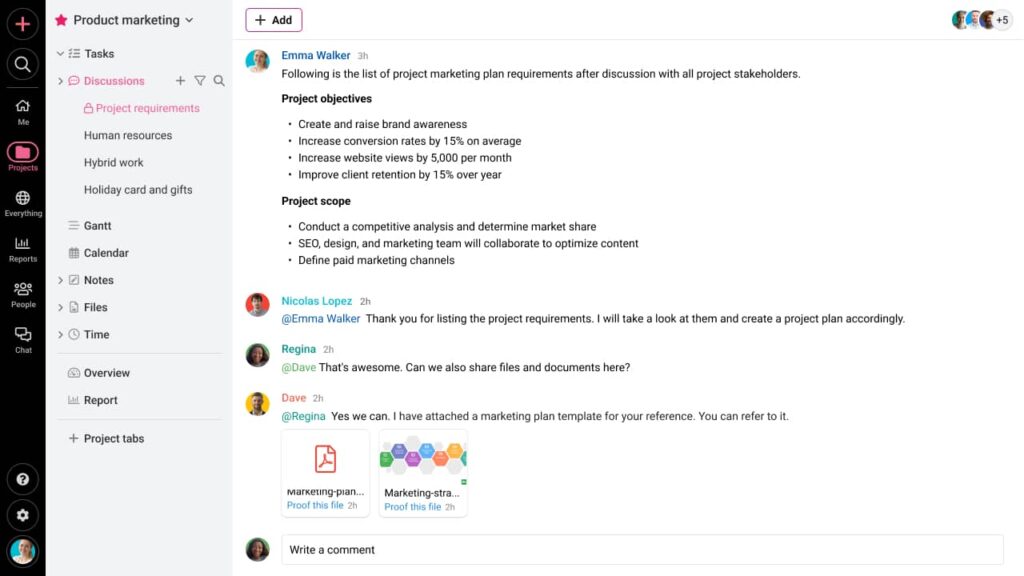
- Discussions & chat: These features are crucial for real-time communication, brainstorming ideas, collaborating on tasks, and building trust within the team. Team members can either talk one-to-one or create a group chat to include multiple team members.
- @Mentions & notifications: Staying informed and keeping others in the loop is essential for effective project management. Furthermore, these features ensure everyone is aware of project updates, task assignments, and discussions, thus ensuring smooth communication and collaboration within the team.
- Information sharing & knowledge management: This tool enables all people-oriented roles to gather project information, and meeting minutes, or create shared knowledge bases effectively. Consequently, this fosters collaboration and team learning, ensuring everyone has access to the latest information for enhanced productivity and cohesion.
2. Tools for action-oriented roles
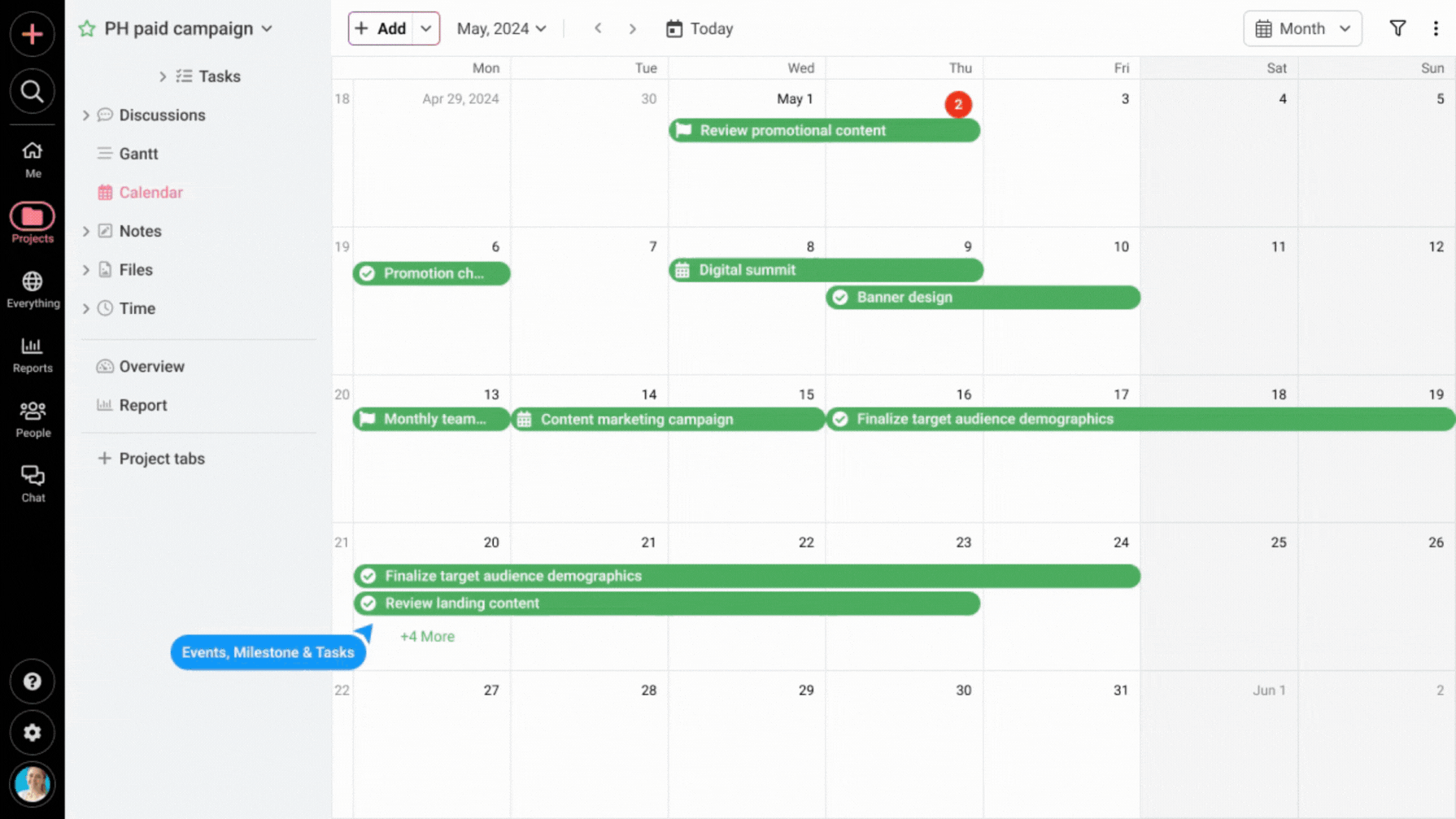
- Task management tools: This core functionality of ProofHub allows action-oriented roles to clearly define tasks, break them down into smaller, actionable steps (subtasks), assign them to specific team members, and set realistic deadlines. For instance, the Implementer of your team can easily define all the details of the task using custom fields.
- Multiple task views: ProofHub offers four different views for everyone on the project team to plan, organize, and manage their work effectively. Moreover, these visual representations are particularly beneficial for action-oriented roles, as they provide a granular view of project information at each level. Consequently, this allows them to prioritize tasks with greater clarity and efficiency.
- Time tracking: ProofHub’s built-in time tracking feature offers detailed timesheets with time spent on each task and subtask. It can help someone like a shaper to come up with better ways to make the team more efficient. For instance, they can refine task estimates using time-tracking data, ensuring they plan future projects with a realistic understanding of the workload.
3. Tools for thought-oriented roles
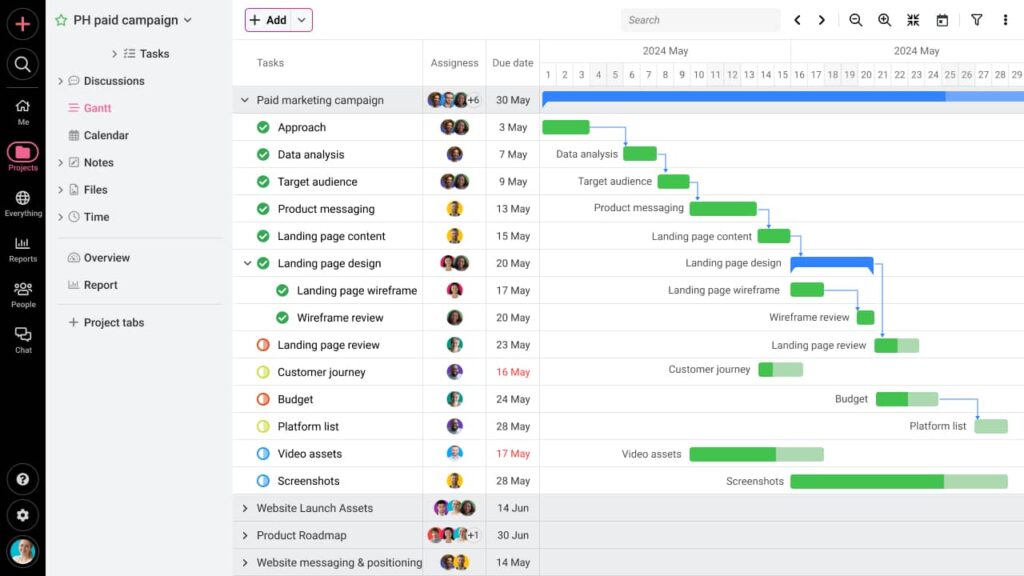
- Gantt charts: Gantt charts offer a big-picture view, with tasks laid out on a timeline and dependencies highlighted. Consequently, this allows for early identification of potential roadblocks and strategic adjustments. Table views complement the chart by providing a detailed breakdown of project data, facilitating deeper analysis and exploration of innovative approaches.
- Reports: Gain data-driven insights with reports that compile project information into clear summaries. Consequently, you can track progress, identify areas for improvement, and make informed decisions. Moreover, reports can spark creative problem-solving in Plants (PLs) by revealing trends and areas for optimization. Meanwhile, Monitor Evaluators (ME) can use reports to proactively assess risks and identify potential issues.
Conclusion
We all wear many hats – a quality that’s more valuable than ever in today’s workplace. By understanding Belbin’s Team Roles, we can create teams where everyone feels confident to contribute their unique strengths. A team has higher potential for success when it nurtures the Plant’s creativity, has the Coordinator keep everyone focused, and has the Implementer translate ideas into action.
This kind of balanced team is highly adaptable, able to tackle new challenges with ease. Project management and team collaboration tools like ProofHub can further improve this adaptability by bringing everything to one unified platform. When the right people are in the right roles, and supported by the right tools, your team can truly thrive in any situation.
Related articles
- Adaptive leadership: The ins and outs of it
- 5 Most common leadership styles & their advantages
- 6 of the best management styles every remarkable manager should strive for
- What makes a good manager (the ultimate guide of dos and don’ts)
- 13 leadership skills you need to lead your team successfully
FAQs
What are the 4 basic roles a team requires to succeed?
Every successful team needs a strong foundation defined by the following 4 basic roles: Leader, Idea generator, Organizer, Team player. The leader provides direction, keeps everyone motivated, and ensures the team is working towards a common goal.
The idea generator brings fresh perspectives and innovative solutions to the table. The organizer keeps the team on track, manages tasks, and makes sure deadlines are met. Finally, the team player collaborates effectively, offers support to others, and helps maintain a positive and productive team environment.
What are some important things to consider when selecting team members and assigning roles?
Building a strong team takes careful consideration. When selecting members and assigning roles, it’s important to match individual skills and strengths to the specific needs of the project.
Additionally, consider how personalities will mesh for effective communication and collaboration. Finally, strive for a balance of roles. Have a good mix of leaders, idea generators, organizers, and team players to cover all aspects of the project.
How can I identify a team member's natural role?
There are several ways to identify a team member’s natural role. One approach is to have team members engage in self-reflection exercises. Additionally, holding open discussions about strengths and interests can provide valuable insights. Alternatively, trying role-playing activities can also help pinpoint where individuals shine within the team.
What if a team member doesn't fit neatly into one role?
People rarely confine themselves to just one role; instead, they often possess a variety of talents and abilities. The key is to leverage these individual strengths while ensuring that the team collectively covers all essential roles.
For instance, a team member who excels at organizing tasks and possesses a knack for creative problem-solving can effectively contribute to both the organizer and idea generator roles.

